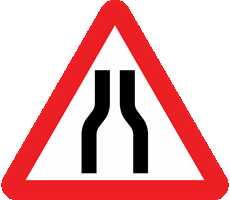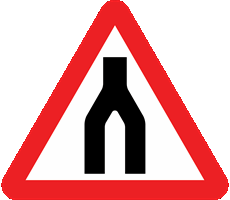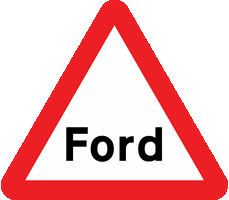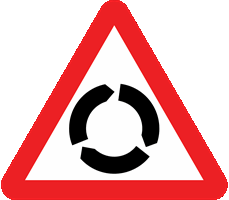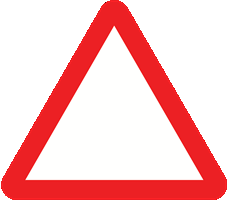
Road Signs Theory Test
Practice for your driving theory test with this free UK road signs test. You need to score 25 out of 30 to pass. These questions are derived from the Highway Code. Good luck!
Click on an answer to view the correct choice along with the explanation.
1. You're approaching a zebra crossing where pedestrians are waiting. Which arm signal might you give?
Mark one answer
B
C
D
Correct Answer: A
Explanation: A 'slowing down' signal will indicate your intentions to oncoming and following vehicles. Be aware that pedestrians might start to cross as soon as they see this signal.
Explanation: A 'slowing down' signal will indicate your intentions to oncoming and following vehicles. Be aware that pedestrians might start to cross as soon as they see this signal.
Correct Answer: B
Explanation: If the road has two lanes, you can use either lane and overtake on either side. Use the lane that's more convenient for your destination unless signs or road markings indicate otherwise.
Explanation: If the road has two lanes, you can use either lane and overtake on either side. Use the lane that's more convenient for your destination unless signs or road markings indicate otherwise.
Correct Answer: B
Explanation: Blue circles tell you what you must do and this sign gives a clear instruction to turn left ahead. You should be looking out for signs at all times and know what they mean.
Explanation: Blue circles tell you what you must do and this sign gives a clear instruction to turn left ahead. You should be looking out for signs at all times and know what they mean.
Correct Answer: D
Explanation: If you're overtaking, make sure you move back safely into the left-hand lane before you reach the end of the dual carriageway.
Explanation: If you're overtaking, make sure you move back safely into the left-hand lane before you reach the end of the dual carriageway.
Correct Answer: B
Explanation: The traffic permitted to use a contraflow lane travels in the opposite direction to traffic in the other lanes on the road.
Explanation: The traffic permitted to use a contraflow lane travels in the opposite direction to traffic in the other lanes on the road.
Correct Answer: B
Explanation: You may cross the solid white line to pass a stationary vehicle or to pass a pedal cycle, horse or road maintenance vehicle if it's travelling at 10 mph or less. You may also cross the solid white line to enter a side road or access a property.
Explanation: You may cross the solid white line to pass a stationary vehicle or to pass a pedal cycle, horse or road maintenance vehicle if it's travelling at 10 mph or less. You may also cross the solid white line to enter a side road or access a property.
Correct Answer: A
Explanation: You shouldn't stop on yellow zigzag lines outside schools, not even to set down or pick up children or other passengers. This is to make sure passing drivers and pedestrians have an unobstructed view.
Explanation: You shouldn't stop on yellow zigzag lines outside schools, not even to set down or pick up children or other passengers. This is to make sure passing drivers and pedestrians have an unobstructed view.
Correct Answer: D
Explanation: Don't force your way through. Show courtesy and consideration to other road users. Although you have priority, make sure oncoming traffic is going to give way before you continue.
Explanation: Don't force your way through. Show courtesy and consideration to other road users. Although you have priority, make sure oncoming traffic is going to give way before you continue.
Correct Answer: A
Explanation: In some built-up areas, you may find the speed limit reduced to 20 mph. Driving at a slower speed will help give you the time and space to see and deal safely with hazards such as pedestrians and other vulnerable road users.
Explanation: In some built-up areas, you may find the speed limit reduced to 20 mph. Driving at a slower speed will help give you the time and space to see and deal safely with hazards such as pedestrians and other vulnerable road users.
Correct Answer: A
Explanation: When traffic lights are out of order, treat the junction as an unmarked crossroads. Be very careful and be prepared to stop; no-one has priority.
Explanation: When traffic lights are out of order, treat the junction as an unmarked crossroads. Be very careful and be prepared to stop; no-one has priority.
Correct Answer: D
Explanation: To make it easy to recognise, the 'stop' sign is the only sign of this shape. You must stop and take effective observation before proceeding.
Explanation: To make it easy to recognise, the 'stop' sign is the only sign of this shape. You must stop and take effective observation before proceeding.
Correct Answer: D
Explanation: Warning signs are there to make you aware of potential hazards on the road ahead. Take note of the signs so you're prepared and can take whatever action is necessary.
Explanation: Warning signs are there to make you aware of potential hazards on the road ahead. Take note of the signs so you're prepared and can take whatever action is necessary.
Correct Answer: C
Explanation: Urban clearways are provided to keep traffic flowing at busy times. You may stop only briefly to set down or pick up passengers. Times of operation will vary from place to place, so always check the signs.
Explanation: Urban clearways are provided to keep traffic flowing at busy times. You may stop only briefly to set down or pick up passengers. Times of operation will vary from place to place, so always check the signs.
Correct Answer: C
Explanation: You should change lanes as directed by the sign. Here, the right-hand lane is closed but the left-hand and centre lanes are available. Merging in turn is recommended when it's safe and traffic is going slowly; for example, at roadworks or a road traffic incident. When vehicles are travelling at speed, this isn't advisable and you should move into the appropriate lane in good time.
Explanation: You should change lanes as directed by the sign. Here, the right-hand lane is closed but the left-hand and centre lanes are available. Merging in turn is recommended when it's safe and traffic is going slowly; for example, at roadworks or a road traffic incident. When vehicles are travelling at speed, this isn't advisable and you should move into the appropriate lane in good time.
Correct Answer: D
Explanation: This sign is found where a shallow stream crosses the road. Heavy rainfall could increase the flow of water. If the water looks too deep or the stream has spread over a large distance, stop and find another route.
Explanation: This sign is found where a shallow stream crosses the road. Heavy rainfall could increase the flow of water. If the water looks too deep or the stream has spread over a large distance, stop and find another route.
Correct Answer: B
Explanation: This sign gives you an early warning that the road ahead will slope downhill. Prepare to alter your speed and gear. Looking at the sign from left to right will show you whether the road slopes uphill or downhill.
Explanation: This sign gives you an early warning that the road ahead will slope downhill. Prepare to alter your speed and gear. Looking at the sign from left to right will show you whether the road slopes uphill or downhill.
Correct Answer: B
Explanation: Obey the 'give way' signs. Trams are unable to steer around you if you misjudge when it's safe to enter the junction.
Explanation: Obey the 'give way' signs. Trams are unable to steer around you if you misjudge when it's safe to enter the junction.
Correct Answer: D
Explanation: As you approach a roundabout, look well ahead and check all signs. Decide which exit you wish to take and move into the correct position as you approach the roundabout, signalling as required.
Explanation: As you approach a roundabout, look well ahead and check all signs. Decide which exit you wish to take and move into the correct position as you approach the roundabout, signalling as required.
Correct Answer: C
Explanation: It will take up to ten times longer to stop when it's icy. Where there's a risk of icy conditions, you need to be aware of this and take extra care. If you think the road may be icy, don't brake or steer harshly, as your tyres could lose their grip on the road.
Explanation: It will take up to ten times longer to stop when it's icy. Where there's a risk of icy conditions, you need to be aware of this and take extra care. If you think the road may be icy, don't brake or steer harshly, as your tyres could lose their grip on the road.
Correct Answer: C
Explanation: This sign is shown where slow-moving vehicles would impede the flow of traffic; for example, in tunnels. However, if you need to slow down or even stop to avoid an incident or potential collision, you should do so.
Explanation: This sign is shown where slow-moving vehicles would impede the flow of traffic; for example, in tunnels. However, if you need to slow down or even stop to avoid an incident or potential collision, you should do so.
Correct Answer: B
Explanation: In order to keep roads free from parked cars, there are some areas where you're allowed to park on the verge. Only do this where you see the sign. Parking on verges or footways anywhere else could lead to a fine.
Explanation: In order to keep roads free from parked cars, there are some areas where you're allowed to park on the verge. Only do this where you see the sign. Parking on verges or footways anywhere else could lead to a fine.
Correct Answer: B
Explanation: The 'no right turn' sign may be used to warn road users that there's a 'no entry' prohibition on a road to the right ahead.
Explanation: The 'no right turn' sign may be used to warn road users that there's a 'no entry' prohibition on a road to the right ahead.
Correct Answer: A
Explanation: No entry' signs are used in places such as one-way streets to prevent vehicles driving against the traffic. To ignore one would be dangerous, both for yourself and for other road users, as well as being against the law.
Explanation: No entry' signs are used in places such as one-way streets to prevent vehicles driving against the traffic. To ignore one would be dangerous, both for yourself and for other road users, as well as being against the law.
Correct Answer: B
Explanation: When a diversion route has been put in place, drivers are advised to follow a symbol, which may be a black triangle, square, circle or diamond shape on a yellow background.
Explanation: When a diversion route has been put in place, drivers are advised to follow a symbol, which may be a black triangle, square, circle or diamond shape on a yellow background.
Correct Answer: D
Explanation: Road markings will warn you of a hazard ahead. A single broken line along the centre of the road, with long markings and short gaps, is a hazard warning line. Don't cross it unless you can see that the road is clear well ahead.
Explanation: Road markings will warn you of a hazard ahead. A single broken line along the centre of the road, with long markings and short gaps, is a hazard warning line. Don't cross it unless you can see that the road is clear well ahead.
Correct Answer: D
Explanation: This type of sign warns you of hazards ahead. Make sure you look at each sign that you pass on the road, so that you don't miss any vital instructions or information.
Explanation: This type of sign warns you of hazards ahead. Make sure you look at each sign that you pass on the road, so that you don't miss any vital instructions or information.
Correct Answer: D
Explanation: Road signs in the shape of a circle give orders. Those with a red circle are mostly prohibitive. The 'stop' sign is octagonal to give it greater prominence. Signs giving orders must always be obeyed.
Explanation: Road signs in the shape of a circle give orders. Those with a red circle are mostly prohibitive. The 'stop' sign is octagonal to give it greater prominence. Signs giving orders must always be obeyed.

B
C
D
Correct Answer: A
Explanation: These signals are found at level crossings, swing or lifting bridges, some airfields and emergency access sites. The flashing red lights mean stop whether or not the way seems to be clear.
Explanation: These signals are found at level crossings, swing or lifting bridges, some airfields and emergency access sites. The flashing red lights mean stop whether or not the way seems to be clear.

B
C
D
Correct Answer: A
Explanation: There might be an occasion where another driver uses an arm signal. This may be because the vehicle's indicators are obscured by other traffic. In order for such signals to be effective, all drivers should know their meaning. Be aware that the 'left turn' signal might look similar to the 'slowing down' signal.
Explanation: There might be an occasion where another driver uses an arm signal. This may be because the vehicle's indicators are obscured by other traffic. In order for such signals to be effective, all drivers should know their meaning. Be aware that the 'left turn' signal might look similar to the 'slowing down' signal.

B
C
D
Correct Answer: C
Explanation: The 'stop' sign is the only road sign that's octagonal. This is so that it can be recognised and obeyed even if it's obscured (for example, by snow).
Explanation: The 'stop' sign is the only road sign that's octagonal. This is so that it can be recognised and obeyed even if it's obscured (for example, by snow).















